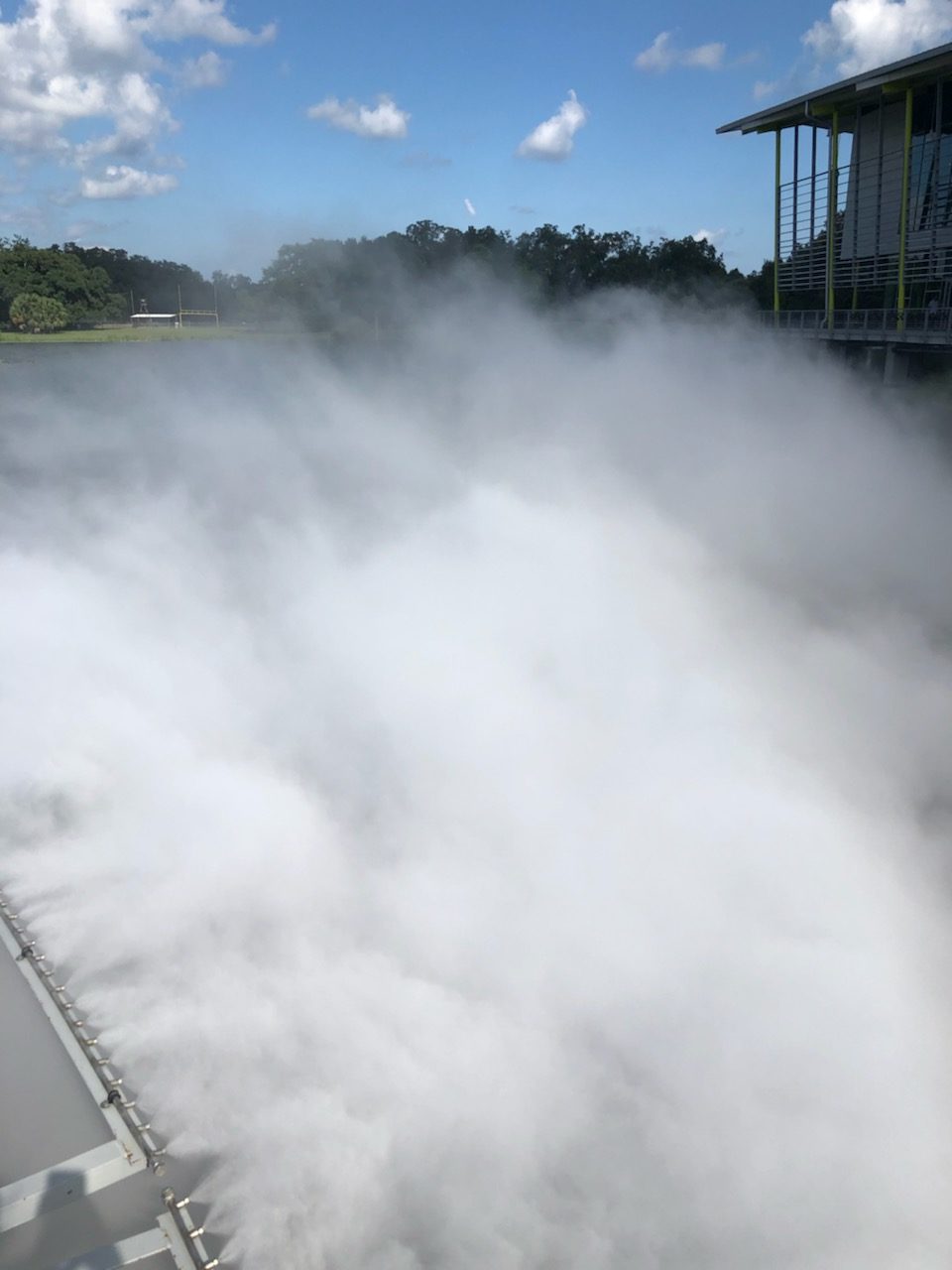
Fog sculpture at its’ peak (Photo: Myles Edmunds)
Almost fifty years ago, Japanese artist Fujiko Nakaya, “enveloped the Pepsi Pavilion at the 1970 World Exposition in Osaka in vaporous fog, becoming the first artist to create a sculptural fog environment.” Nakaya’s sculpture captured attention and imagination of the art world, and her installations have been installed “all over the world from the Guggenheim Museum in Bilbao to the Australian National Gallery in Canberra to the grounds of the Philip Johnson Glass House in New Canaan, Ct.” As of the summer of 2019, with the opening of the Louisiana Children’s Museum’s new campus in New Orleans City Park, New Orleans has been added to this impressive list of cities with a Fujiko Nakaya installation. Situated among “the majestic live oak trees of City Park, the new, $47.5 million project includes a LEED-certified building situated on and over a lagoon that shapes this site.” This is only the second permanent installation in the United States and first in the American South. The expansive project “complements the new museum’s focus on water and the ecology of coastal Louisiana.”
Explaining the purpose and meaning behind fog sculptures, Fujiko Nakaya explained “[i]n fog, visible things become invisible and invisible things-like wind-become visible. Air looks as if it is empty, but there is so much going on in it. Often I try to design a microenvironment for the fog to behave at its best-to dance with the wind.” Too often, we travel the world consumed with our everyday lives, doing things like going to class or scrolling through Instagram. Although we remain part of nature, we neglect to experience it. Even when we are outside, traveling from one place to another, we are engaged on our phones or in conversation. Fujiko’s installation forces visitors to experience nature, or at least that’s its purpose. As she puts it, [i]t’s a way to have a dialogue with nature. We’ve been using nature too much, and now it’s time for nature to speak up” (3).
When I visited the so-called installation, a strange feeling came over me as I stood on a bridge overlooking the Mississippi. A beautiful setting was around me, but I hardly noticed at first. Instead of feeling like I was experiencing nature, I felt like I was waiting for nature to happen. You cannot control fog or nature, it is free to move as it pleases. This was the opposite of what I found here. At the installation, the fog has very strict times of going on and off – it is only for about three minutes every thirty minutes. In fact, I had to visit twice in order to experience the fog, having left the first time as it closed before it even went off. When the fog begins, it engulfs you, makes you wet as it touches you, and then evaporates. It was a cool experience, but it did not make me feel like I was having a dialogue with nature. It made me feel like the installation was attempting to artificially recreate nature in a contrived way – in three minute increments every thirty minutes. As the fog subsided, I was left standing on the bridge again looking at the Mississippi River, but now I suddenly felt more in tune with nature. The art exhibit had indirectly caused me to focus on nature – the Mississippi River and my surroundings, in a way I hadn’t before.
Art has always been linked to nature, seascape painting reminds people of the view of the beach, while pastoral painting takes them back to time spent in the country. Fujiko Nakay has expressed this notion, stating “[i]t is very Japanese to copy nature. My father, Ukichiro Nakaya, made the first artificial snow crystal. He used to say, ‘You must listen to ice if you want to learn about ice’ He always said that you have to be humble, surrender to nature in order for nature to speak.” In order to surrender to nature, you have to be free from distractions. This hardly ever happens in modern life. Nobody ever “stops and smells the roses anymore.” People are so busy with their lives and all the things they need to accomplish on any given day that they often fail to notice the natural beauty around them, whether it’s the sky, a river, fog or even a flower.
Fujiko Nakaya’s fog installation brought me to a natural setting, where I put my phone away and experienced the moment in her alternative art form. Although I found it to be somewhat contrived, it fulfilled its purpose as it brought me face to face with nature, causing me to be in touch with my natural surroundings. As the man-made fog subsided, I stopped, like the narrator in Frost’s poem, and took it in the fact that I was standing on a bridge overlooking the Mississippi River, a beautiful sight to behold. On any other day, I probably would not have even noticed, but today I was communed with nature.
Sources
stopping-by-woods-on-a-snowy-evening-by-robert-frost. Accessed 20 Sept. 2019.
 NOLAbeings
Multimedia artist Claire Bangser created NOLAbeings as a portrait-based story project that marries...
NOLAbeings
Multimedia artist Claire Bangser created NOLAbeings as a portrait-based story project that marries...
 Data corner: Adobe Suite (create a PDF, social media graphic, presentation, edit a photo and video
Data corner is where you go to work with analytics and top tech skills. It takes on everything from PERL and SQL to Canva and Sprout Social.
Data corner: Adobe Suite (create a PDF, social media graphic, presentation, edit a photo and video
Data corner is where you go to work with analytics and top tech skills. It takes on everything from PERL and SQL to Canva and Sprout Social.
